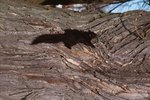
Gray squirrels (Sciurus carolinensis) are a common sight throughout much of the eastern United States and Canada. These small, tree-dwelling rodents fit easily into a number of habitats due to their remarkable adaptability. Gray squirrels are easily recognized by their gray coat (varying from yellowish gray to pure silver, though different color morphs exist), ruffed tail and cream-colored underbelly.
Geography
Gray squirrels are native to the eastern part of the United States and southeastern Canada, with a range stretching from Quebec south to Florida and west into the eastern third of Texas. Gray squirrels can be found outside of this range, however, as they have been introduced into Oregon, Washington, California, Montana and British Columbia. Outside of the North America, gray squirrels were introduced into England, Ireland, Scotland and Italy, where populations thrive.
Habitat Features
Gray squirrels prefer mature hardwood or mixed deciduous forests of continuous area, though they will also readily inhabit suburban and urban areas. Gray squirrels have the densest populations in large forested areas with trees that supply them with plenty of diverse and available nut trees, like oak, hickory and walnut. These squirrels most often can be found in tree-filled areas near permanent sources of open freshwater. Though they easily adapt to numerous environments, gray squirrels do require trees with nesting cavities for reproduction and security, so they are not found in open grasslands or deserts.
Ecological Role
Gray squirrels provide a source of food for many predatory species within their habitat, including many birds of prey (eagles, hawks, falcons, owls and ospreys), weasels, foxes, coyotes, wolves, bobcats and lynxes. They are also hunted by humans for population control, sport or food throughout much of their range.
Gray squirrels predominantly feed on tree nuts, but will also eat flowers, seeds, fungi, insects and even the occasional bird eggs. In addition to serving as an important prey species, the nut storing tendencies of the gray squirrel help to disperse tree seeds within their habitat.
Adaptability
Gray squirrels have been able to adapt to a number of habitats, as their native environments have become more urbanized and forests cleared. Though they require trees for nesting, squirrels will occasionally make use of outside leaf nests, eaves and attics, allowing them to thrive in suburban and urban areas, and areas without heavy forest cover. Because gray squirrels have a relatively flexible diet (and because acorns--a very common nut in many yards and parks--are a large part of their diet), they are able to further adapt to changing environmental conditions.
References
Photo Credits
-
Jupiterimages/Photos.com/Getty Images




